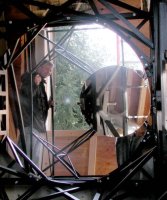 Carl Sagan: Founder and First President of The Planetary Society
Carl Sagan: Founder and First President of The Planetary Society
Carl Edward Sagan was born in November 9,1934 and died in December 20, 1996. An astronomer, educator and author, Sagan was perhaps the world's greatest popularizer of science, reaching millions of people through newspapers, magazines and television broadcasts.
He is well-known for his work on the PBS series Cosmos, the Emmy- and Peabody-award-winning show that became the most watched series in public-television history. It was seen by more than 500 million people in 60 countries.
The accompanying book, Cosmos (1980), was on The New York Times bestseller list for 70 weeks and was the best-selling science book ever published in English.
Sagan is co-founder of the Planetary Society, a 100,000-member organization and the largest space-interest group in the world. The society supports major research programs in the radio search for extraterrestrial intelligence, the investigation of near-Earth asteroids and, with the French and Russian space agencies, the development and testing of balloon and mobile robotic exploration of Mars. Sagan was also Distinguished Visiting Scientist at the Jet Propulsion Laboratory in California and was contributing editor of Parade magazine, where he published many articles about science and about the disease that he battled for the last two years of his life, Myelodysplasia.
Sagan received a Bachelor's degree in 1955 and a Master's degree in 1956, both in physics, and a Doctorate in Astronomy and Astrophysics in 1960, all from the University of Chicago. He taught at Harvard University in the early 1960s before coming to Cornell, where he became a full professor in 1971. Sagan played a leading role in NASA's Mariner, Viking, Voyager and Galileo expeditions to other planets. He received NASA Medals for Exceptional Scientific Achievement and twice for Distinguished Public Service and the NASA Apollo Achievement Award.
 Bruce Murray: Founder and former Chairman of The Planetary Society
Bruce Murray: Founder and former Chairman of The Planetary Society
Dr. Murray , 69, is Professor Emeritus of Planetary Science and Geology at the California Institute of Technology in Pasadena , California. He has been at Caltech since 1960 and currently teaches courses in Planetary Surfaces and supervises graduate student research.
He was Director of the NASA/Caltech Jet Propulsion Laboratory from 1976 to 1982, which included the Viking landings on Mars and the Voyager mission through Jupiter and Saturn encounters. In 1979, he, the late Carl Sagan and Louis Friedman founded The Planetary Society, a 100,000 member international organization dedicated to exploring the Solar System and to the search for extra-terrestrial intelligence (SETI). He currently serves as the President of TPS.
Dr. Murray was a member of the Mars Television Teams on Mariner 4 (1965), Mariners 6 and 7 (1969), and Mariner 9 (1971-72). He was the Television Team leader for the Mariner 10 flyby of Venus and Mercury (1973-75), and a member of the scientific teams of the Russian Phobos '88 mission (partially successful) and the unsuccessful Russian Mars 96 mission. He is member of the very successful US Mars Global Surveyor mission, and also of the scientific teams for the US Mars Polar Lander and the Mars Microprobes which were lost in December, 1999.
Dr. Murray has a long-standing interest in structured ways to analyze and visualize potential future outcomes of alternative societal and natural circumstances, beginning with his book "Navigating The Future" (Harper Row, 1975). He was a consultant to the "2050 Project", a collaboration between WRI, The Brookings Institution, and the Santa Fe Institute from 1991-95. From 1993 to 1999 he worked with the John and Mary Markle Foundation to determine how new information technology may be developed to facilitate deliberative discourse on critical issues. Currently , he is a key participant in the "Closer to Truth" media endeavor with responsibility for the web site www.closertotruth.com.
He has published over 130 scientific papers and authored or co-authored six books. He received his college education at M.I.T., culminating in the Ph.D. in 1955.
 Louis Friedman: Founder and Executive Director, The Planetary Society
Louis Friedman: Founder and Executive Director, The Planetary Society
Louis D. Friedman comes from New York, and brings a wealth of experience to the Planetary Society and the space exploration community. He worked for 10 years at the Jet Propulsion Laboratory and five at AVCO Space Systems Division on civilian and military space programs.
Friedman began his college career when Sputnik launched the space age. He received a B.S. in applied Mathematics and Engineering Physics at the University of Wisconsin in 1961, followed by an M.S. in Engineering Mechanics at Cornell University in 1963.
In 1970 -1980, Friedman joined the JPL and helped plan many deep space missions. His projects included Mariner-Venus-Mercury, the Grand Tour (Voyager), Venus Orbital Imaging Radar (Magellan), Halley Comet Rendezvous-Solar Sail, and the Mars Program.
In 1978 -79 at Washington, DC he worked on the staff of the subcommittee on Science, Technology, and Space of the Senate Committee on Commerce, Science and Transportation as the the AIAA Congressional Fellow.
 Humor found here.
Humor found here. 

